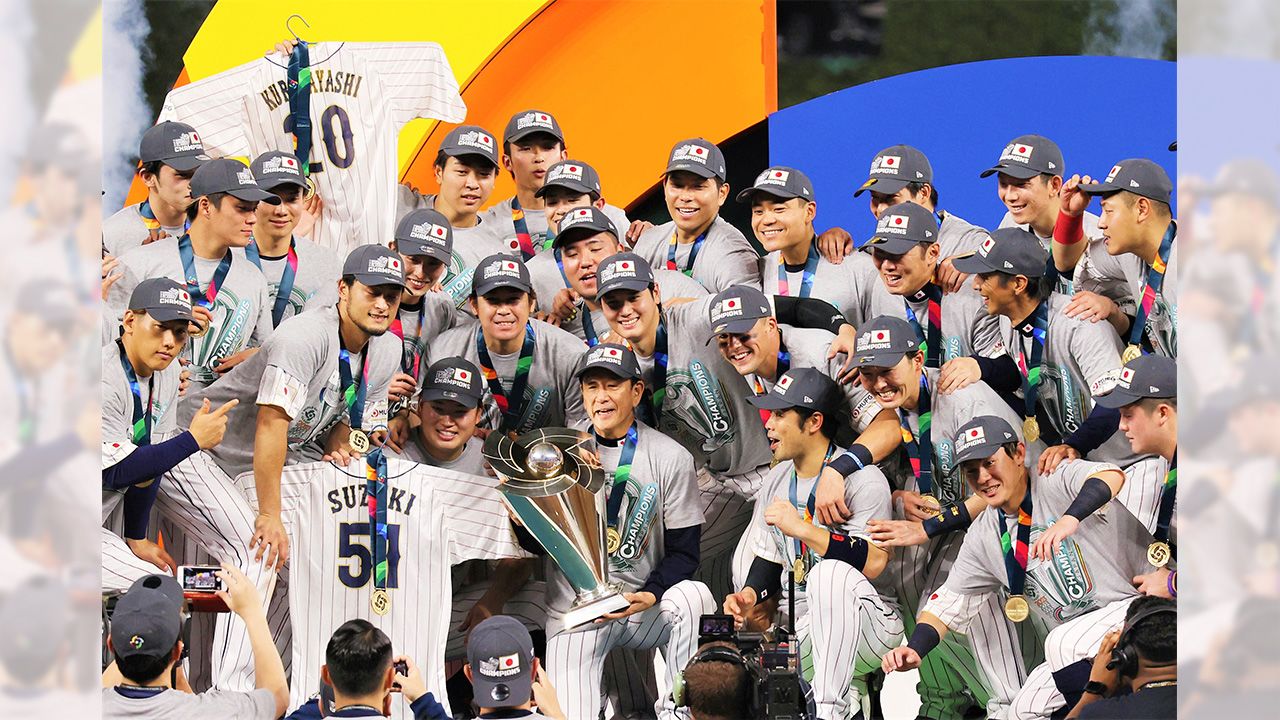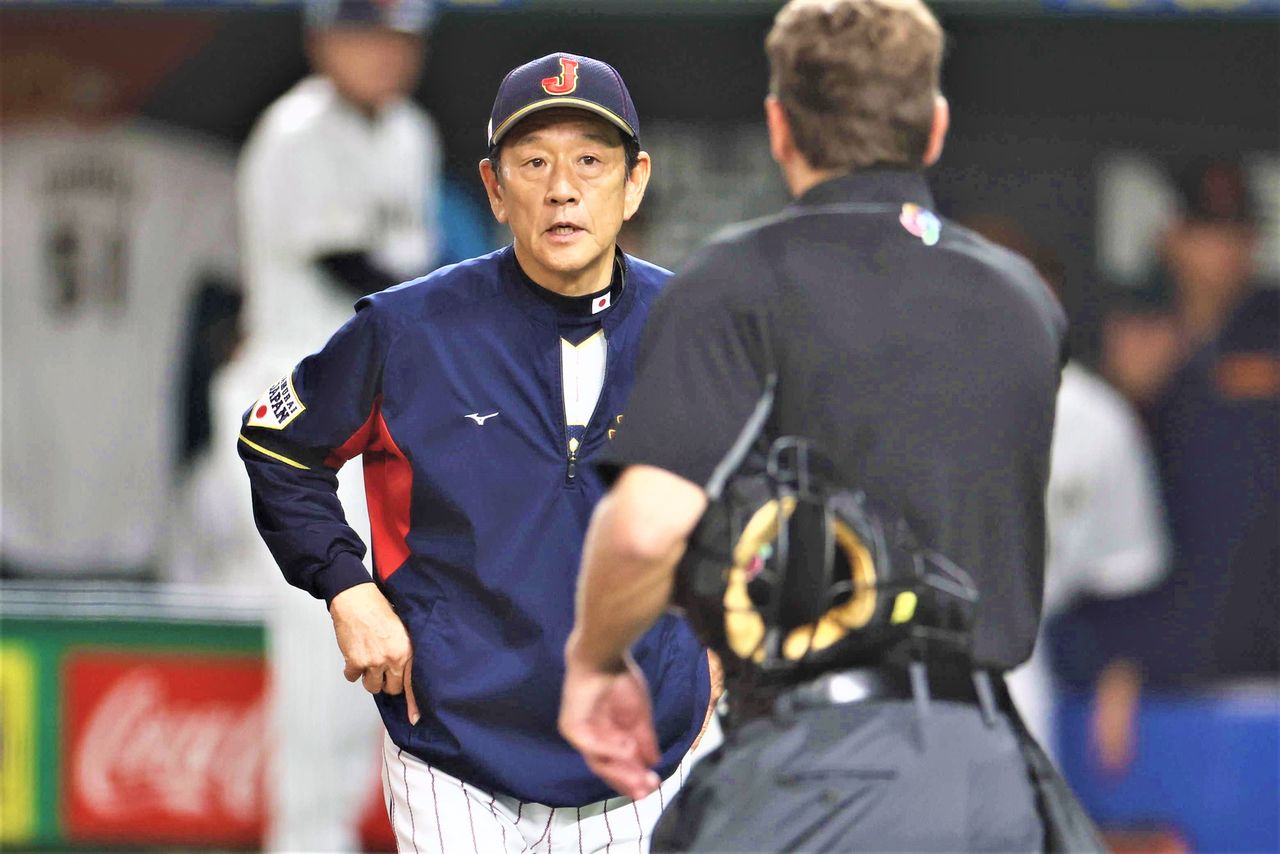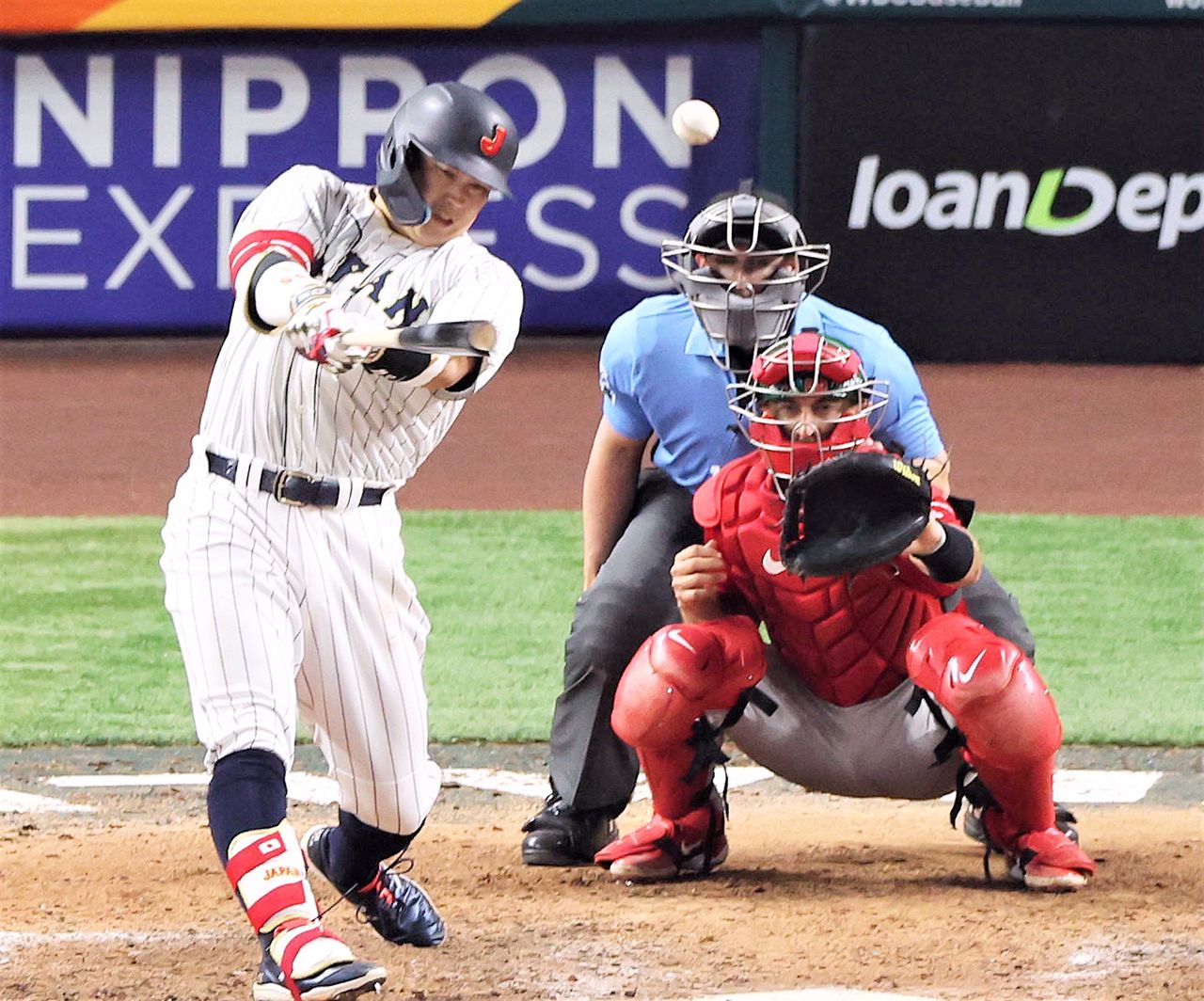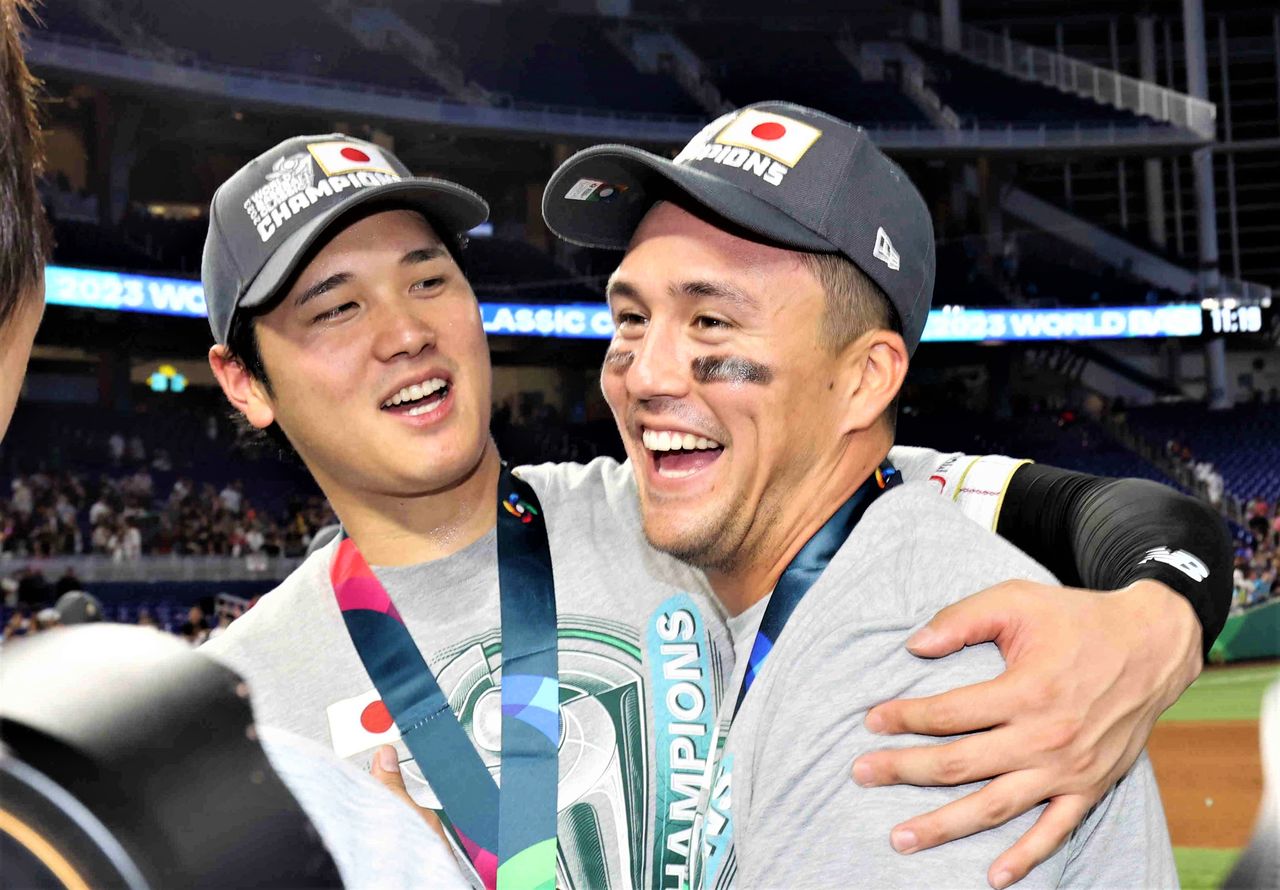
Samurai Japan Breaks Free from the Small Baseball Approach
Sports- English
- 日本語
- 简体字
- 繁體字
- Français
- Español
- العربية
- Русский
A Fresh Approach to Winning for Japan
This World Baseball Classic, the fifth ever held, finished on March 21, 2023, with a Japanese 3–2 win over the United States. This victory gave Samurai Japan its third WBC championship, following wins in 2006 and 2009.
Team manager Kuriyama Hideki led the team to victory over an all-star US squad, hailing from the home of baseball, at the final game held in Miami, Florida. “All Japan’s players were nothing but smiles,” he said immediately after the win. “This made me happier than anything else.” But this game told a story bigger than just the joy of the win. Attention focused on how Kuriyama had reshaped the Japanese game to a more powerful form of baseball as he led the team to the top.
Historically, Japan’s approach to the game has been technically proficient “small ball”: getting a batter on base and building on that with well-aimed hits and sacrifice bunts to advance the runner, stolen bases, and other techniques aimed at building a lead inning by inning. Samurai Japan traditionally deployed techniques like these as it went up against teams from North and Latin America, with their deep rosters of Major League stars.
But this small-ball approach, which had been at the foundation of previous Japan squads, was nowhere to be seen in this year’s tournament. Here lies Kuriyama’s main achievement with the 2023 national team.
Some data on the team’s performance in previous tournaments bears this out: the number of attempted sacrifice bunts in each of the World Baseball Classics so far.
- 2006 (managed by Oh Sadaharu): 9 bunts
- 2009 (Hara Tatsunori): 7 bunts
- 2013 (Yamamoto Kōji): 6 bunts
- 2017 (Kokubo Hiroki): 9 bunts
While a straight comparison may not be possible due to the different numbers of games played by each squad, these numbers do make it clear that the sacrifice bunt has traditionally been a part of Samurai Japan’s strategy. In the 2023 tournament, though, Kuriyama’s team attempted bunts just three times.
The first two of these came in games where they were not key plays expected to impact the outcome. The first was in the preliminary round match against the Czech Republic, when Kai Takuya got the signal to bunt in the fourth inning, with no outs, one man on base, and Japan already in the lead by two runs. The second came against Australia, with Nakamura Yūhei up to bat in the second inning, again with no outs and a runner already on first, and Japan already enjoying a comfortable three-run lead.
Samurai Japan’s third bunt of the tournament did not come until the semifinal game against Mexico. In the bottom of the eighth inning, with Japan down 5–3, Genda Sōsuke was up to bat, with runners on first and second and no outs. He failed to connect with the ball twice, but Kuriyama delivered the bunt signal a third time, and Genda made it work, sending the runners to second and third. A sacrifice fly by Yamakawa Hotaka brought one run home, setting the stage for Japan’s comeback win in the final inning. This third bunt may indeed have been the only one in the tournament deployed by Kuriyama as part of Japan’s strategy.

Japan manager Kuriyama Hideki addresses an umpire at the game against the Czech Republic on March 11, 2023, at Tokyo Dome. (© Jiji)
Behind the Strategic Change
It goes without saying, of course, that a major factor behind this new focus on aggressive batting was the presence on team Japan of offensive threats like Ohtani Shōhei of the Los Angeles Angels and Murakami Munetaka of the Tokyo Yakult Swallows.
One incident exemplifying Kuriyama’s move away from small ball to a more powerful offense came when outfielder Suzuki Seiya (Chicago Cubs) had to be pulled from the roster just before the tournament due to an oblique muscular strain. The manager had originally put Ohtani second in the lineup, but this decision was based on the availability of Suzuki to bat third. Kuriyama aimed to build a potent, balanced front end for the lineup, with Lars Nootbaar (Saint Louis Cardinals) first, followed by Ohtani and Suzuki, and Japan triple-crown winner Murakami batting cleanup.
With Suzuki out of the picture, though, Kuriyama had to change plans. He moved Ohtani to third on the list, and after considering which batters would best fill the second slot, where he wanted someone with a high chance of getting on base, he decided on Kondō Kensuke (Fukuoka Softbank Hawks). “Kon-chan,” as Kuriyama called him, “is going to be one key for this team’s success.”
At this point Kuriyama had moved well away from small ball and into the realm of robust offense at the plate. He was clearly aiming not to get bunts that would put someone into potential scoring position, but to create scoring chances more immediately by hitting hard. With this, he had broken free from the traditional Japanese approach to the game.
He stuck to this new course to the very end of the tournament. A particularly memorable game showcasing this dedication was the semifinal match against Mexico. In the bottom of the ninth, down 5–4, Samurai Japan managed to get runners on first and second with no outs. Up to bat was Murakami, a powerhouse during the previous season in Japan but facing a serious batting slump in WBC play, raising fears that he could ground into a double play and deal Japan’s chances a serious blow.
Any of the managers who had helmed the Japanese team in the past might be expected to tell Murakami to bunt and advance the runner, if not to send out a designated hitter in his place to do the same. Murakami himself says that as he headed toward the batter’s box, he saw infield and baserunning coach Shiroishi Noriyuki appear from the dugout, at which point he expected to get the signal to bunt.
Kuriyama had made a different call, though. His message, delivered via Shiroishi, was for Murakami to swing for the fences. The result, a double that brought both runners home, took Japan to the finals against the United States.

Murakami Munetaka hits a double to drive home the winning runs in the bottom of the ninth inning against Mexico on March 20, 2023, in Miami, Florida. (© Jiji)
“There’s something about Mune that you can’t fail to believe in,” said Kuriyama later about Murakami. “I was telling him all tournament, ‘in the end we’re going to win with your bat.’”
Throughout the World Baseball Classic, there was worried talk about Murakami and his poor performance at the plate. Starting with the quarterfinal game against Italy, he was moved from fourth to fifth in the rotation, but this failed to pull him out of the slump. Samurai Japan’s manager, though, waited patiently for the slugger to do what he knew he was capable of.
The trend toward “big ball” in Japan has grown more pronounced in recent years. In the 2019 Nippon Professional Baseball season, Tokyo Yomiuri Giants manager Hara Tatsunori slotted in infielder Sakamoto Hayato as second batter, where his offense helped win the Central League pennant for the team. Since then, many teams have built more aggressive batting orders around a strong second batter.
There is one even older example of this, though: none other than Kuriyama himself, as manager of the Hokkaidō Nippon Ham Fighters. In the April 6, 2017, game against the Chiba Lotte Marines, he tapped pitcher/batter Ohtani Shōhei as the team’s designated hitter, placing him second in the lineup. At the time, the number-two slot was overwhelmingly seen as a bridging position between first batters with a high on-base percentage and clean-up sluggers. Ohtani himself seemed unsure about how to perform in this slot, and the experiment came to an end after just one game.
Kuriyama, though, was clearly already thinking about the number-two batter as a key offensive role, and not just a bridge between the team’s main threats. His big-ball philosophy aimed to coax maximum performance out of the second batter as well, bringing overwhelming firepower to bear against opposing teams.
Six years later, the 2023 World Baseball Classic would see this philosophy bear fruit at last.
Proving the Potential of the Japanese Game
Japan is today taking on the rest of the baseball-playing world as a true equal. When it won the first two WBC tournaments, held in 2006 and 2009, it did so by drawing opponents into the Japanese style of play and beating them on its own turf, so to speak. The 2023 win, in comparison saw Japan staking out its own territory on the Major League–style stage and beating its opponents at the big-ball game. This was a championship celebrated at home in Japan even as it showcased the potential of Japanese baseball to the global audience.
Taking the field for Japan in this year’s tournament were a number of Major League players—Ohtani, pitcher Darvish Yū (San Diego Padres), outfielder Yoshida Masataka (Boston Red Sox), and Lars Nootbaar, whose mother is Japanese. The star-studded roster made the WBC games more popular than ever in the Japan market. In the United States, meanwhile, captain Mike Trout (Ohtani’s teammate on the Los Angeles Angels) convinced big names like outfielder Mookie Betts (Los Angeles Dodgers) and first baseman Paul Goldschmidt (Saint Louis Cardinals) to come onboard, forming a powerful team that captivated American audiences as well.

Ohtani Shōhei (at left), chosen as the tournament’s most valuable player for his hitting and pitching, embraces Lars Nootbaar, whose energetic play made him a fan favorite in Japan. Taken on March 21, 2023, in Miami, Florida. (© Jiji)
Overall, the 2023 WBC was a success that made the case for the tournament as a way to determine the best team in the world. This does not mean it was without its problems, though.
One of them was pointed out by Kuriyama Hideki at a press conference after his return to Japan. Darvish Yū, he noted, had been able to join the team for practice starting with the pretournament camp held in Miyazaki Prefecture in February. But WBC rules prevented him and the other Major Leaguers from taking part in any pretournament practice games until March 6, just two days before the WBC kicked off. This made it difficult for him to get into pitching shape, said the manager.
“Ordinarily, it’d be unthinkable to put a pitcher on the mound after so few pitches in practice competition. But the rules stated he couldn’t be out there. We did have him pitch in one exhibition match against the Chūnichi Dragons, but then all of a sudden, he has to go in for the real thing against South Korea. It’s this sort of thing that makes it hard for Major League players to take part. I’ve asked for some more understanding from the MLB administrators on this point.”
Southpaw pitcher Clayton Kershaw (Los Angeles Dodgers) had hoped to take the field for Team USA, but when an insurance company covering him refused to extend coverage to the nonleague tournament, he had to give up.
Ohtani has said he hopes to play for Samurai Japan once again in 2026, when the sixth World Baseball Classic will take place. But three years from now, he is likely to be locked into one of the highest-paying contracts in Major League history. In a situation like that, no matter how much he wants to play, insurance providers may have other ideas, as they did in Kershaw’s case.
All in all, it appears that there are many obstacles still to overcome if the WBC is to be a true “World Cup of baseball.” Nevertheless, this tournament, which started out as something of nebulous value to the world of baseball, has grown into something truly important to the sport.
As Mexico manager Benjamín Gil said after his team’s March 20 loss to Japan in the semifinal round, “Japan advances, but the baseball world won tonight.”
Team USA manager Mark DeRosa echoed this sentiment in his comments after Samurai Japan came out on top the next evening: “The baseball fans won tonight.”
These are not the kind of words one hears from sore losers. Indeed, Japan’s achievements on the field in the United States, the birthplace of baseball, have given rise to a fresh groundswell of popularity for the sport. This makes me hopeful that three years from now, in the next World Baseball Classic, we will see a tournament that takes things one step further.
(Originally written in Japanese. Banner photo: Manager Kuriyama Hideki, at center, holds the 2023 World Baseball Classic champion’s trophy while surrounded by the members of Samurai Japan. Taken on March 21, 2023, at LoanDepot Park in Miami, Florida. © Jiji.)